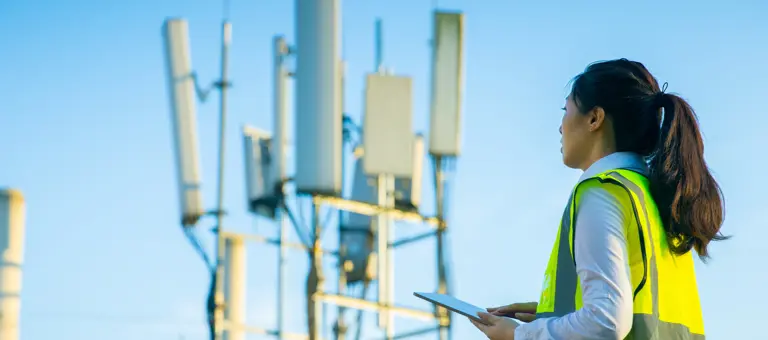
Sustainability leadership, priorities and value creation potential in Telco
8 min read 20 February 2024
In the wake of COP28, the Ofcom Connected Nations report and political shifts in the UK government commitment to Net Zero, we look at what this means for telecommunications (telco) organisations looking to achieve meaningful impact against their climate and sustainability goals in 2024.
The role of businesses in realising national and global climate goals was emphatically stated by United Nations Framework Convention on Climate Change (UNFCCC) Executive Secretary Simon Stiell in his COP28 closing speech. “… businesses need to turn these pledges into real-economy outcomes, without delay.”1
Whilst the imperative is clear, organisations continue to grapple with how to do so in a commercially viable and impactful way.
This is the first in our two-part article series where we look at how Telco companies can rapidly and effectively deliver against their climate and sustainability strategies by understanding and implementing their organisational priorities. In this article, we will share insights on:
- Climate and sustainability priorities for the telco sector – reducing greenhouse gas (GHG) emissions (and more), closing the digital divide, evidencing the impact with effective data management.
- The value creation potential of climate and sustainability – with a telco network example focussing on design, build or operations to identify the biggest wins for your organisation.
Our second article - Delivering impact for sustainability leaders in the telecommunications sector - will be released shortly and will share insights on ensuring action delivers impact, taking a stakeholder centric approach to executon and landing and embedding the change.
Key climate and sustainability priorities for the telco sector
Telcos, or ‘the connectivity industry’, has a major role to reduce global greenhouse gas (GHG) emissions and close the digital divide.
Reduce GHG emissions
Organisations need to reduce both direct and indirect GHG emissions attributable to company owned sources, purchased energy, upstream and downstream supply chains - agnostic of scale, maturity, and business model. This can be tackled from infrastructure design through to operational execution.
- Sustainable design of fixed and wireless network infrastructure2
- Resilient networks that adapt to climate change
- Maximise energy efficient technologies e.g. 5G, full-fibre
- Actual reduction in energy consumption and emissions intensity3
- Public commitment to and progress against science-backed net zero targets
- Migration and switch off of legacy networks
- 100% renewable energy sourcing to power operations
- Align to SDG 7 by consuming sustainable energy4
- Direct sourcing to increase energy security and economy.
Developing the long term, credible view on climate transition plans is step 1 – leaders in this space are going beyond supporting national and global emission reduction targets to look at resources more broadly (water use, agriculture, circularity, digital skills) as routes to new markets and future revenue opportunities.
Close the digital divide
As we increasingly become a world of ‘digital nations,’ we need equal access to high-speed connectivity for all members of society to fully participate and ensure that inequality is not exacerbated by digital poverty.5 Access, skills and devices need to be addressed collectively for this to succeed.
Digital inclusion is a global imperative, though the specific interventions to achieve it will be determined by the organisation’s domestic context. The political, industrial, natural resource and cultural context within a given geography are key, with the organisational profile of capital, operations, employees, and governance shaping the prioritisation of inclusion initiatives.
For the Global North, organisations need to focus on three key areas:
- Ensure equal access (physical infrastructure and cost to connect) regardless of geography and socioeconomic group.6
- Integration into rollout plans for commercial build.
- Engagement with public sector initiatives, e.g. Project Gigabit, Social tariffs
- Enable utilisation by enhancing digital skills.
- Collaboration with dedicated digital inclusion organisations to leverage organizational capacity and capability.7
- Support access to the necessary devices to put this to use.
- Collaboration with dedicated digital inclusion organisations to supply equipment.8
- Design operations and consumption of goods and services to drive a circular economy model.9
Underpinning these three priorities is effective data capture, management, and disclosure in a dynamic, rapidly evolving regulatory environment at the global and national level.
Thriving organisations can take a long-term view on risk, political uncertainty and emergent technology to deliver societal impact.
Starting with the value creation potential of climate and sustainability
It is impossible to overstate the urgency and criticality of the climate crisis. However, this isn’t always the most effective starting point when trying to land the importance of being a leader in sustainability. The benefits for businesses are manifold and position climate and sustainability as an enabler of growth.

Opportunities vary across the value chain – a telco Network example
Identifying organisational-level risks and opportunities can be understood by where investment and activity is focused within the value chain. As an organisation matures and evolves this emphasis and the associated climate and sustainability priorities are likely to transition.
Example: Current and emerging ‘Alt nets’ in the full fibre broadband space are experiencing a shift in the weighting of investment from network design to network build. In the next 3-5 years self-build will be nearing completion and emphasis will again shift to operational activity with costs largely driven by energy consumption. So too, the associated climate and sustainability risks and opportunities for the business. A dynamic, phased approach to addressing the climate crisis is therefore critical.

Read the second article in this two-part series - Delivering impact for sustainability leaders in the telecommunications sector - to find out how to ensure action delivers impact, take a stakeholder centric approach to execution, and discuss the direct and indirect levers to landing the change. To find out more about the priorities and value creation potential of climate and sustainability in the telco sector, get in touch with Jon Roberts or Darshan Grover.
1 ‘COP28 Agreement Signals “Beginning of the end” of the Fossil Fuel Era’; United Nations Climate Change; December 2023
2 Ofcom Connected Nations 2023
3 Ofcom Connected Nations 2023
4 Transforming our world: the 2023 Agenda for Sustainable Development; UN; 2015
5 National Delivery Plan: Overview; Data Poverty Alliance; 2022
6 Future Telecoms Infrastructure Review; BDUK; 2022
7 National Digital Inclusion Network
8 Digital Nation; Good Things Foundation; 2023
9 ‘Intelligent Assets: Unlocking the Circular Economy Potential’; WEF and Ellen MacArthur Foundation; 2016
10 Who cares? Who does?; Kantar, 2023
11 Sustainability Linked Loan Principles; LMA, 2019
12 Consumers’ Sustainability Demands are Rising ‘; Forbes; 2023
13 UK Wireless Infrastructure Strategy; Policy paper; 2023
14 ‘Our digital infrastructure needn’t cost the earth’; Carbon Smart, CityFibre, 2018
15 ‘Developing a generic approach for FTTH solutions using LCA methodology’; PwC Ecobilian; 2008
Our Experts


Related Insights

Bridge the gap between Telco and Techco with AI-driven customer experience
Telcos stand at a crossroads. Networks are commoditising and products are converging, while new, disruptive technologies and competitors rewrite the rules of engagement. These shifts are compelling telecoms companies to rethink their traditional roles as connectivity providers.
Read more
Achieving a step change in operational excellence by leveraging automation and AI across your end-to-end processes
Telecoms providers across the globe face a fundamental dilemma. Core products and services are becoming commodities, making it difficult to raise prices. As a result, revenue growth remains muted.
Read more
Telco to Techco: A Blueprint for Industry Reinvention
Market saturation, commoditisation of connectivity, increasingly digital customer expectations, and technological innovation has left Telcos at an inflection point.
Read more
From telco to techco: Why telecoms must transform for a new era of communications and technology convergence
The telecoms industry is facing an existential moment. As traditional models come under increasing pressure, telecoms companies must evolve beyond their traditional role as connectivity providers and reposition themselves as techcos.
Read moreRelated Client Stories

Transforming service delivery to unlock ROI for a global telecommunications provider
A global telecommunications provider was struggling with fragmented service operations and limited visibility across its customer lifecycle. Legacy systems and siloed processes were slowing response times, inflating costs, and constraining the business’s ability to scale.
Read more
How Baringa supported Colt Technology with its CRM transformation
Join our TMT Partner Dan Nicholson, as he talks to our client Colt Technology
Read more
We talk to our client KCOM about modernising business operations
Join our TMT Director Sarah Roberts, as she talks to our client Tim Shaw, CEO at KCOM
Read more
Building a trusted data platform to enable scaling and cost savings
How do you accelerate delivery of a £multi-billion network expansion programme using advanced analytics and targeted insight?
Read moreIs digital and AI delivering what your business needs?
Digital and AI can solve your toughest challenges and elevate your business performance. But success isn’t always straightforward. Where can you unlock opportunity? And what does it take to set the foundation for lasting success?